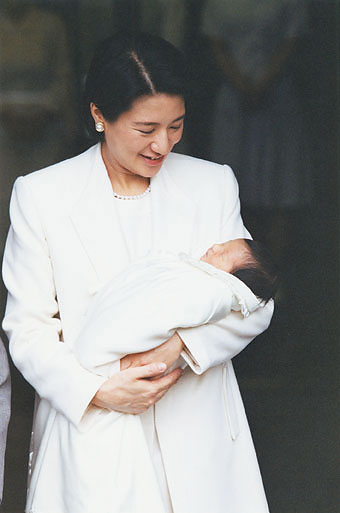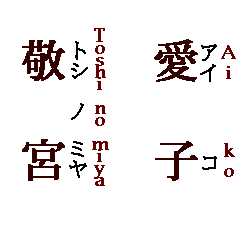|
 On
December 1, 2001, Crown Princess Masako gave birth to a baby girl. The
baby weighed 3,102 grams and was 49.6 centimeters long at birth. At the
traditional naming ceremony on the seventh day of her life, the girl was
given the name Aiko and the personal title Toshi no Miya, Princess Aiko.
"Ai" means love, "ko" means child and is often used as the last character
in girl's names, and "toshi" means respect. She is the Crown Prince and
Princess's long-awaited first child, born eight years after they got married
in 1993, and is Emperor Akihito's third grandchild. With Princess Aiko's
birth, the number of members of the Imperial
Family has risen to 25. On
December 1, 2001, Crown Princess Masako gave birth to a baby girl. The
baby weighed 3,102 grams and was 49.6 centimeters long at birth. At the
traditional naming ceremony on the seventh day of her life, the girl was
given the name Aiko and the personal title Toshi no Miya, Princess Aiko.
"Ai" means love, "ko" means child and is often used as the last character
in girl's names, and "toshi" means respect. She is the Crown Prince and
Princess's long-awaited first child, born eight years after they got married
in 1993, and is Emperor Akihito's third grandchild. With Princess Aiko's
birth, the number of members of the Imperial
Family has risen to 25.
In line with its long traditions the
Japanese Imperial Family takes part in a variety of ceremonies every year,
and when a child is born a number of special ones are held. Such rituals
have taken place since the Heian
period (794-1185), but the style used today dates from about 100 years
ago.
The first ceremony, performed on the day the baby was born, was the sword-giving ceremony, in which the Emperor presented the newborn child with a protective sword and a formal note that she will receive a hakama (traditional formal skirt). The sword and note were first shown to the Crown Prince and then placed at the new princess's bedside.
On the seventh day after birth the
bathing ceremony and naming ceremony were held. The bathing ceremony was
held in a room divided by a white curtain. On one side of the curtain
the baby princess was bathed. On the other side a person wearing traditional
clothing of the Heian
period read a passage from the Nihon
shoki (Chronicle of Japan), while two others in similar costume
plucked the strings of ceremonial bows. The purpose of this ceremony is
to pray for the learning and health of the child.
 In the naming ceremony, the Emperor decided the name and personal title of the new princess and told them to the Crown Prince. This is a formality, however, as it was actually the Crown Prince and Princess who chose the name together. There are some customs about the names of members of the Imperial Family: Names tend to be made up of two characters. Boys' names usually contain the character hito, meaning virtue, and girls' names contain the character ko, meaning girl. The personal title of a prince or princess, which is used while they are young, contains the character miya (meaning prince or princess).
In the naming ceremony, the Emperor decided the name and personal title of the new princess and told them to the Crown Prince. This is a formality, however, as it was actually the Crown Prince and Princess who chose the name together. There are some customs about the names of members of the Imperial Family: Names tend to be made up of two characters. Boys' names usually contain the character hito, meaning virtue, and girls' names contain the character ko, meaning girl. The personal title of a prince or princess, which is used while they are young, contains the character miya (meaning prince or princess).
The Crown Prince and Princess chose a kind of azalea (Rhododendron Quinquefolium) as the symbol of their child. They chose this flower to express their wish that Princess Aiko will grow up to have a pure heart like the flower's pure white color.
After the naming ceremony the baby's name was written in the Record of Imperial Lineage. This registers the names, parents, and dates and times of birth of members of the Imperial Family and is stored at the Imperial Palace. Another copy is placed in the Ministry of Justice.
The birth of Princess Aiko is the first piece of good news in Japan for a long time. About 765,000 people all over the country signed books of congratulation, and many events were held to celebrate, as the whole country showed its happiness over the news.
Photo: Crown Princess Masako holds Princess Aiko. (Imperial Household Agency)
|

